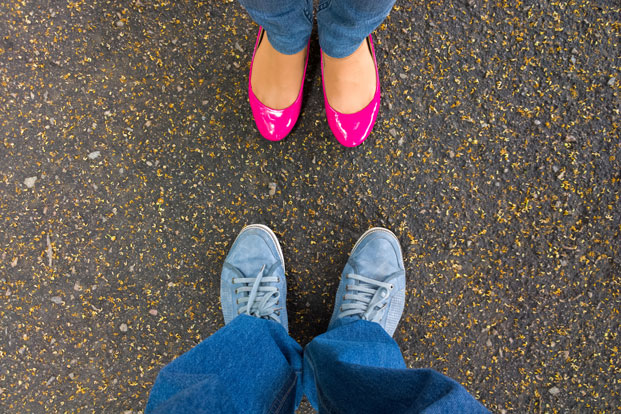Swanky stilettos and strappy sandals can give your ensemble an instant upgrade. They can make you look and feel taller (and slimmer), and perhaps make boost your confidence. But they can also leave you with aches and pains. According to a study by The College of Podiatry in London, it takes only one hour and six minutes of wearing ill-fitting or uncomfortable shoes to feel pain, which can range from blisters to muscle issues. And while high heels get a bad rap, they aren’t the only style of footwear that can leave you feeling sore. Even your favorite pair of flip-flops can leave you at an increased risk for injury, including stress fractures.
More than 43 million Americans, or roughly one out of every six people, have problems with their feet, according to the American Academy of Orthopaedic Surgeons. Many of these problems are caused or exacerbated by poor footwear choices. Women who wear high heels to work all week, for example, wind up with shortened calf muscles and can alter the bone structure in the foot, putting them at greater risk for everything from bunions to pulled tendons. And with the average height of a high-heeled shoe climbing to five inches from three inches, women increase their risk of injury every time they strap on their favorite designer shoes.
If you’re having a hard time finding shoes that are cute AND comfortable, you’re not alone. A survey from the American Orthopaedic Foot and Ankle Society found that 50 percent of women were dissatisfied with their ability to find dress shoes that were both fashionable and comfortable, despite the fact that 60 percent of women claim to pay between $50 to $200 for a pair of shoes.
Footwear Affects The Whole Body
The shoes we choose affect more than just our feet. According to CNN, studies have shown that prolonged high-heel wearing can contribute to joint degeneration and knee osteoarthritis, which may be why this disease is twice as common in women as it is in men. Heels throw the entire body’s alignment off, changing the center of balance and leading to increased curvature in the back,which can cause the discs in the spine to break down and lead to muscle spasms and pain throughout the body. Some experts think that it can even lead to chronic headaches or migraines.
Because damage from footwear happens slowly, we’re often more likely to overlook the signs that we’re developing foot (or knee or back) problems until the damage has been done and there are few options to reverse it. And once we’ve damaged our feet, we can develop a more sedentary lifestyle, which can lead to weight gain and myriad other health problems as a result of decreased physical fitness.
As a general rule, the most important factor in finding ideal footwear for your feet is to find shoes that fit properly. According to the Society of Chiropodists and Podiatrists, you should look for the following when selecting footwear:
Wiggle Room
When trying on shoes, make sure you can wiggle your toes inside your shoes to avoid developing or aggravating bunions. As a general rule, you want to make sure there is 1/2 inch of space between the end of your longest toe and the end of the shoe.
Not All Feet Are Created Equal
Most people have one foot that is slightly larger than the other, so you should always try on both shoes and walk several steps in them to identify any areas that may pinch or rub, which will lead to blisters and other problems later.
Let It Breathe
Choose shoes that are made of leather or materials that allow your feet to breathe and that will mold well to the shape of your foot, rather than squishing feet and causing cramps.
Shop at the End of the Day
Most people have feet that swell throughout the day as a result of regular activities. When you shop for shoes in the morning, you’re not going to get a sense of how the shoes will fit once your feet swell. Instead, shop for shoes at the end of the day so that you get a good sense of what will fit you when your feet are at their largest.
Look for Sole
The soles of your shoes should provide cushioning and protection for comfortable walking and should have enough traction to prevent slip and fall accidents.
Keep It Low
When shopping for heels, bigger isn’t better. You should look for shoes that have low, stable heels and good arch support. Because women’s feet are more likely than men’s to pronate, or turn inward, than men’s feet, the arch support will help redistribute weight throughout the foot to prevent that. Ideally, heels should be lower than two inches, but if you’re going big for a glamorous night out, limit the amount of time that you spend in your spikes and give your feet some extra pampering afterward.
Consider Flats
Flats are all the rage and are much better for our feet than high heels. The trick is to find flats wide enough to fit your feet comfortably, provide adequate arch support, and don’t have exposed seams on the inside that can rub against your feet and cause blisters.
Dress for the Task
Even if you have to dress in heels for work, you should consider what kind of commute you have to and from the office and wear comfortable walking shoes to and from work. If you’re going to stand on your feet all day for work, consider shoes that will cushion and support your feet, rather than stilettos. And if you’re going to be traveling, hiking or otherwise engaged in activities that will have you walking long distances, opt for sneakers over sandals, flip-flops or dress shoes.

Leave a Reply